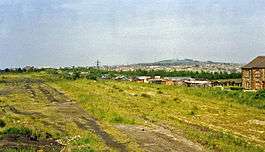Consett railway station
| Consett | |
|---|---|
|
Consett railway station site in 1988, after demolition, view northeast towards Annfield Plain, by Ben Brooksbank | |
| Location | |
| Place | Consett |
| Area | County Durham |
| Coordinates | 54°51′04″N 1°49′38″W / 54.8510°N 1.8273°WCoordinates: 54°51′04″N 1°49′38″W / 54.8510°N 1.8273°W |
| Operations | |
| Original company | North Eastern Railway |
| Pre-grouping | North Eastern Railway |
| Post-grouping | London and North Eastern Railway |
| Platforms | 2 |
| History | |
| 17 August 1896 | Station opens |
| 23 May 1955 | Station closes |
| Disused railway stations in the United Kingdom | |
|
Closed railway stations in Britain A B C D–F G H–J K–L M–O P–R S T–V W–Z | |
|
| |
Consett railway station was a railway station on the Stanhope and Tyne Railway, in County Durham, Northern England. It served the industrial town of Consett, which was best known for its steelworks.
History
Opened on 17 August 1896 by the North Eastern Railway, it became part of the London and North Eastern Railway during the Grouping of 1923. The station then passed on to the Eastern Region of British Railways on nationalisation in 1948.
It wasn't the first station to serve the town however, as one had been opened by the NER in 1862 as the terminus of its Lanchester Valley Railway from Durham.[1] This lasted only five years however, the LVR was extended northwards to Newcastle via Lintz Green & Scotswood and a new station was opened at Benfieldside on the northern edge of the town. This was renamed "Consett" in 1882 and again to "Consett & Blackhill" (as it was closer to the later community) in 1885, before eventually becoming Blackhill when the 1896 depot opened.[1] This station was located on the former S&T route east of the intersection with the Durham - Blackhill - Scotswood line and opened on the same day that passenger trains began running to Newcastle via Annfield Plain and a junction with the East Coast Main Line near Birtley (a chord line having been built by the NER to link the main line with the S&T route where they crossed each other). Travellers from the new station could also use the Derwent Valley line via Blackhill to reach Newcastle by means of a link line between the two routes that had been commissioned in 1893 - this alternative route was actually a couple of miles shorter but had a less frequent service. Facilities were quite basic, with wooden buildings in the middle of the island platform linked via a sloping path to the road overbridge at the eastern end.[1]
Passenger services on the Derwent Valley line via Lintz Green were withdrawn by the British Transport Commission north of Blackhill on 1 February 1954 and those on the line from Ouston Junction to Blackhill followed on 23 May 1955, with the station closing to passenger traffic on that date.[1] Goods traffic continued to be handled at the station until 2 October 1967, the line from Blackhill having closed to all traffic four years previously.[2]
The ex-S&T line through the station latterly remained in use to serve the nearby steelworks until they closed in September 1980 and then subsequently for the demolition trains used to clear the site. The last passenger train (a railtour special) called on 17 March 1984[3] and the line closed completely shortly afterwards, despite calls to reinstate passenger services from Newcastle to serve the town and the Beamish Museum. The tracks were lifted later that year and the station demolished.
Today the site and the station approaches have been lost under the rebuilt A692 road.[1]
| Preceding station | Disused railways | Following station | ||
|---|---|---|---|---|
| Rowley Line and station closed |
London and North Eastern Railway Stanhope and Tyne Railway |
Carrhouse Line and station closed | ||
References
- Butt, R. V. J. (1995). The Directory of Railway Stations: details every public and private passenger station, halt, platform and stopping place, past and present (1st ed.). Sparkford: Patrick Stephens Ltd. ISBN 1-8526-0508-1. OCLC 60251199.
- Jowett, Alan (March 1989). Jowett's Railway Atlas of Great Britain and Ireland: From Pre-Grouping to the Present Day (1st ed.). Sparkford: Patrick Stephens Ltd. ISBN 1-8526-0086-1. OCLC 22311137.
- Jowett, Alan (2000). Jowett's Nationalised Railway Atlas (1st ed.). Penryn, Cornwall: Atlantic Transport Publishers. ISBN 0-9068-9999-0. OCLC 228266687.
- Station on navigable O.S. map
Notes
- 1 2 3 4 5 Disused Stations - ConsettDisused Stations Site Record; Retrieved 22 April 2016
- ↑ Disused Stations - Blackhill Retrieved 22 April 2016
- ↑ A brief look at the Tyne Dock - Consett iron ore workings www.derbysulzers.com; Retrieved 27 September 2013
